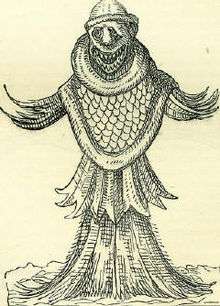Sea monk

The sea monk (also monk-fish or monkfish) was a sea creature found off the eastern coast of the Danish island of Zealand in 1546.[1] It was described as a "fish" that looked superficially like a monk, and was mentioned and pictured in the fourth volume of Conrad Gesner's famous Historia Animalium. The most recent study concluded that the animal was most likely an angelshark.[1]
History
Early sources described the sea monk as a "fish" that looked superficially like a monk, and was mentioned and pictured in the fourth volume of Conrad Gesner's famous Historia Animalium. Gesner also referenced a similar monster found in the Firth of Forth after Boethius.
The sea monk was subsequently popularised in Guillaume du Bartas's epic poem La Sepmaine; ou, Creation du monde, where the poet speaks of correspondences between land and sea, mentioning both the "mytred Bishop" and the "cowled Fryer":
"Seas have (as well as skies) Sun, Moon, and Stars;
(As well as ayre) Swallows, and Rooks, and Stares;
(As well as earth) Vines, Roses, Nettles, Millions,
Pinks, Gilliflowers, Mushrooms, and many millions
of other Plants lants (more rare and strange than these)
As very fishes living in the Seas.
And also Rams, Calfs, Horses, Hares, and Hogs,
Wolves, Lions, Urchins, Elephants and Dogs,
Yea, Men and Mayds; and (which I more admire)
The mytred Bishop and the cowled Fryer;
Whereof, examples, (but a few years since)
Were shew'n the Norways, and Polonian Prince."
Explanations

In the early 1850s, Danish zoologist Japetus Steenstrup suggested that the sea-monk was a giant squid,[2] a theory more recently popularised by writer Richard Ellis.[3] Cryptozoologist Bernard Heuvelmans believed the report was based on the discovery of an errant walrus.[4]
More recently, it has been suggested that it was an angelshark Squatina squatina, which is commonly called "monkfish" in English or munk in Norwegian and Danish.[1] Other suggested suspects for the sea monk include a grey seal, a hooded seal, a monk seal, or a hoax such as a Jenny Haniver.[1]
See also
References
- 1 2 3 4 Paxton, C. G. M. & R. Holland (2005). Was Steenstrup Right? A new interpretation of the 16th century sea monk of the Øresund. Steenstrupia 29: 39–47.
- ↑ Steenstrup, J.J.S. (1855). Om den i Kong Christian IIIs tid i Øresundet fanget Havmund (Sømunken kaldet) Dansk Maanedsskrift 1: 63–96.
- ↑ Ellis, R. (1998). The Search for the Giant Squid. Lyons Press. London.
- ↑ Heuvelmans, B. (1974). Dans le Sillage des Monstres Marins. Famot. Geneva.